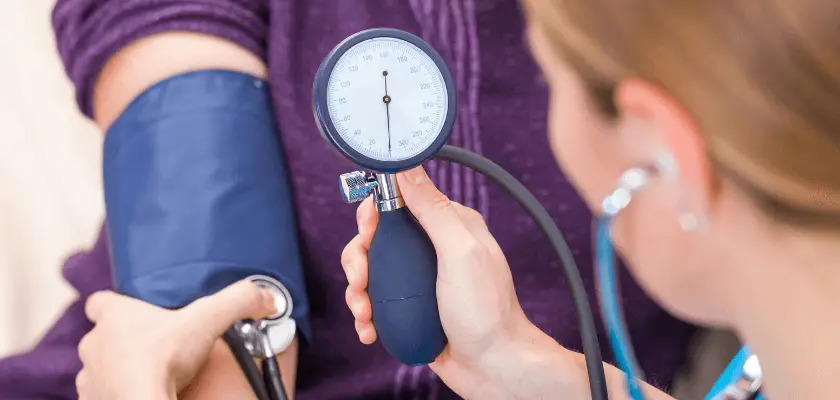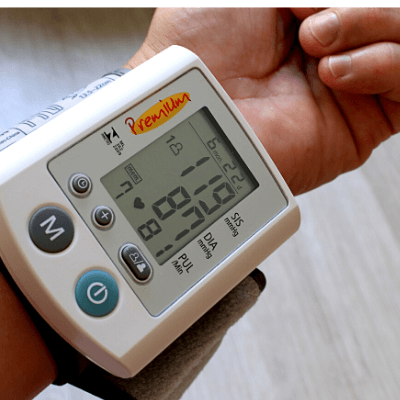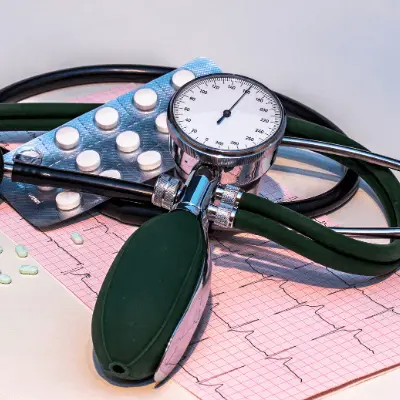Risk Factors For High Blood Pressure

During the last decade, the number of Americans with high blood pressure has increased by 30%. However, there are many risk factors for high blood pressure.
Risk Factors For High Blood Pressure
Over 65 million American adults now have high blood pressure, and this condition affects close to 1 billion people worldwide.
Less than half of these people are on medication, however, and only about half of this group have their blood pressure under good control with such drugs.
Older people are less likely to be treated adequately. The majority of people with high blood pressure have a mild type, but even this condition requires attention.
Age and Gender Risk Factor
Age is the major risk factor of hypertension.
Blood pressure increases with age in both men and women, and in fact, the lifetime risk for hypertension is nearly 90%.
Two-thirds of Americans over age 60 have hypertension. Older women (60 years and above) currently have the highest rates of hypertension, and mortality rates from hypertension are higher in women than in men.
Hypertension is also becoming more common in children and teenagers.

Ethnicity Risk Factors
Compared to Caucasians, African Americans have 1.8 times the rate of fatal stroke, 1.5 times the risk for fatal heart disease, and 4.2 times the rates of end-stage kidney disease.
In general, about 34% of African American men and women have hypertension; it may account for over 40% of all deaths in this group.
The prevalence of high blood pressure among African Americans is among the highest in the world.
The rates of hypertension in Hispanic Americans, Caucasians, and Native Americans are about equivalent (ranging from 24 – 27%).
The rate is much lower in Asian/ Pacific Islanders (9.7% in men and 8.4% in women). However, nearly 75% of older Japanese American men are hypertensive. Clearly, ethnicity is a risk factor for high blood pressure.
Why is There a Difference in High Blood Pressure Among Ethnicities
A number of theories have addressed the reasons for this difference:
- African Americans may have lower levels of nitric oxide and higher levels of a peptide called endothelin-1 (ET-1) than Caucasians. Nitric oxide keeps blood vessels flexible and open, and ET-1 narrows blood vessels.
- African Americans have a higher risk for an impaired response to angiotensin (Ang II), which is a peptide important in regulating salt and water balances. African Americans are more likely to be salt-sensitive than other groups.
- Social and income disparities and dietary issues may explain many of the differences in blood pressure rates observed between ethnic groups.
- For example, while African Americans have a disproportionately high rate of hypertension, one study in rural African villages, where diets are rich in fish, reported only a 3% rate of high blood pressure among inhabitants.
- Another study reported that Caucasian, as well as African Americans in the Southeast, have a higher incidence of hypertension and stroke than people in other U.S. regions.
- The Southeast also has a higher rate of obesity, stress, anxiety, and depression, and diets low in potassium and high in salt, all related to a lower socioeconomic level.
- African Americans have a higher prevalence of risk factors (cardiovascular disease, obesity, diabetes, and kidney disease) that are associated with hypertension.

In any case, hypertension appears to be dangerously undertreated in major minority groups.
Inadequately controlled hypertension is the major factor for the higher mortality rate from heart disease among African Americans, and special treatment considerations need to be addressed in this population.
A treatment consensus statement released by the International Society on Hypertension in Blacks (ISHIB) advises that many African Americans may need at least two medications to help lower their blood pressure.
Effects of Weight on Blood Pressure
About one-third of patients with high blood pressure are overweight. Even moderately obese adults have double the risk of hypertension than people with normal weights.
Moreover, the increase in blood pressure in aging Americans may be due primarily to weight gain. (In other cultures, old age does not necessarily coincide with weight gain or high blood pressure.)
Children and adolescents who are obese are at greater risk for high blood pressure when they reach adulthood. Thinness. Interestingly, thin people with hypertension are at higher risk for heart attacks and stroke than obese people with high blood pressure.
Experts think that thin people with hypertension are likely to have conditions such as an enlarged heart or stiff arteries that cause the blood pressure to rise and also pose greater dangers to health.
Low Birth Weight Effects on High Blood Pressure
Low Birth Weight. Low birth weight, particularly in girls, has been associated with high blood pressure in both childhood and adulthood.
One study suggested that breastfeeding these babies may help reduce this risk.
Another study reported high levels of stress hormones in babies with low birth weight, which could increase the risk of high blood pressure later on. Low birth weight is also associated with subsequent obesity, a major contributor to hypertension.

Diabetes Affect on High Blood Pressure
Up to 75% of cardiovascular problems in people with diabetes may be due to hypertension. There are strong biologic links between insulin resistance (with or without diabetes) and hypertension.
It is unclear which condition causes the other. Some experts believe angiotensin may be the common factor linking diabetes and high blood pressure.
This natural chemical not only influences all aspects of blood pressure control but also interferes with insulin’s normal metabolic signaling.
People with diabetes or chronic kidney disease need to reduce their blood pressure to 130/80 mm Hg or lower to protect the heart and help prevent other complications common to both diseases.
Lowering systolic pressure may be particularly important for people with diabetes.
Effects of Family on High Blood Pressure
Studies suggest that spouses of people with high blood pressure are at a much higher risk as well. Such findings indicate that dietary and environmental factors play a role in this disease.
Some evidence also indicates that higher risk in spouses may be due to people often choosing mates who are similar to them. Family History and Genetics.
Essential hypertension may be inherited in 30 – 60% of cases. According to one study, being a brother or sister of someone with premature coronary artery disease is a greater risk factor for hypertension than having a parent with the disease.
A family history of heart disease is considered to be a major risk factor for high blood pressure in adults under age 65.
 Atherosclerosis is a common disorder of the arteries.
Atherosclerosis is a common disorder of the arteries.Emotional Factors
People who are anxious or depressed may have over twice the risk of high blood pressure than those without these problems.
Mental Stress. Recent evidence confirms the association between stress and hypertension. In one 20-year study, men who periodically measured highest on the stress scale were twice as likely to have high blood pressure as those with normal stress.
The effects of stress on blood pressure in women were less clear. Job stress and lack of career success have been specifically linked to high blood pressure in both men and women.
Anxiety. Studies suggest that anxiety is a risk factor for hypertension, particularly in women.
Depression. Mounting evidence suggests that depression has physiological effects that impair the heart and that it contributes to destructive behaviors, such as weight gain, smoking, or alcohol abuse.
In one study, those who scored the highest on a depression test had about twice the risk of high blood pressure as those with the lowest score.
This link was particularly strong in African Americans. Depression was the strongest risk factor in this group.
Time and Seasonal Factors on High Blood Pressure
Blood pressure levels tend to be lowest during the morning and midday hours and highest at the end of the day.
Seasonal changes also affect blood pressure, with hypertension increasing during cold months and declining during the summer.
Blood pressure readings can vary by as much as 40% depending on the time of day and season.
Conclusion
High blood pressure is a silent killer. However, with good lifestyle choices, you can have a good, healthy blood pressure! The risk factors for high blood pressure can be eliminated with a proper lifestyle.
Age Group | Blood Pressure
|
20-29 | ███
30-39 | █████
40-49 | ███████
50-59 | █████████
60-69 | ██████████
70+ | ███████████
Phyllis Robinson MSN, RN is a Registered Nurse of 27 years. Phyllis is passionate about the prevention and healing of heart disease using traditional and alternative methods. She has experience in emergency room, telemetry, infusion, and critical care. Phyllis currently practices in an intensive care unit.

